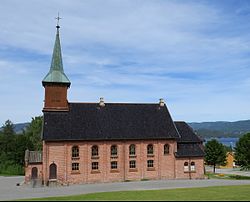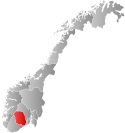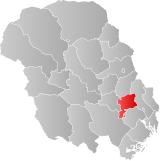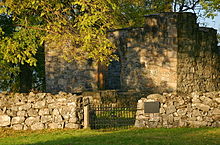Holla, Telemark
Holla Municipality
Holla herred | |
|---|---|
| Hollen herred (historic name) | |
 View of the local church | |
 Telemark within Norway | |
 Holla within Telemark | |
| Coordinates: 59°16′57″N 9°15′56″E / 59.28245°N 9.26547°E | |
| Country | Norway |
| County | Telemark |
| District | Grenland |
| Established | 1 Jan 1838 |
| • Created as | Formannskapsdistrikt |
| Disestablished | 1 Jan 1964 |
| • Succeeded by | Nome Municipality |
| Administrative centre | Ulefoss |
| Area (upon dissolution) | |
• Total | 252 km2 (97 sq mi) |
| Population (1964) | |
• Total | 4,352 |
| • Density | 17/km2 (45/sq mi) |
| Demonym | Hollasokning[1] |
| Official language | |
| • Norwegian form | Neutral[2] |
| Time zone | UTC+01:00 (CET) |
| • Summer (DST) | UTC+02:00 (CEST) |
| ISO 3166 code | NO-0819[4] |
Holla is a former municipality in Telemark county, Norway. The 252-square-kilometre (97 sq mi) municipality existed from 1838 until its dissolution in 1964. The area is now part of Nome Municipality. The administrative centre was the village of Ulefoss. The municipality was considered part of the traditional district of Grenland, but in 1964 it became been part of the new Nome municipality which has been considered to be part of the Midt-Telemark district.[5]
History
[edit]The parish of Hollen (later spelled Holla) was established as a municipality on 1 January 1838 (see formannskapsdistrikt law). On 1 January 1866, an unpopulated area of Bø Municipality was transferred into Holden Municipality. During the 1960s, there were many municipal mergers across Norway due to the work of the Schei Committee. On 1 January 1964, the district of Valebø (population: 259) on the eastern side of the lake Norsjø was merged into Skien Municipality. On the same date, the rest of Holla (population: 4,093) was merged with the neighboring Lunde Municipality (population: 3,080) to form the new Nome Municipality.[6]
Name
[edit]The municipality (originally the parish) is named after the old Hollen farm (Old Norse: Hǫllin) since the first Holla Church was built there. The first element is derived from the word hallr which means "sloping" or "leaning". The last element is derived from the word vin which means "meadow" or "pasture".[5][7] Historically, the name of the municipality was spelled Holden. In 1889, the spelling was changed to Hollen. On 3 November 1917, a royal resolution changed the spelling of the name of the municipality to Holla.[8]
Churches
[edit]The Church of Norway had one parish (sokn) within the municipality of Holla. It was part of the Øvre Telemark prosti (deanery) in the Diocese of Agder og Telemark.
| Parish (sokn) | Church name | Location of the church | Year built |
|---|---|---|---|
| Holla | Helgen Church | Helgja | 1735 |
| Holla Church | Ulefoss | 1867 | |
| Romnes Church | Romnes, just north of Ulefoss | 1100s |

Holla Church ruins
[edit]The Old Holla Church was a medieval stone church, situated near the Holla gård in today's Ulefoss. The church had a view over lake Norsjø. Today only the ruins (Holla kyrkjeruin) are left.[9]
Holla Church
[edit]Holla Church (Holla Kirke) is a Gothic Revival-style church which dates from 1867. The church was donated to the community by Severin Diderik Cappelen (1820-1881) who was the owner of Ulefos Jernværk and served as mayor in Holla. The structure is made of brick and has about 600 seats. The architect was Peter Høier Holtermann (1820-1865). The church was restored during 1916.[10]
Government
[edit]While it existed, this municipality was responsible for primary education (through 10th grade), outpatient health services, senior citizen services, unemployment, social services, zoning, economic development, and municipal roads. During its existence, this municipality was governed by a municipal council of directly elected representatives. The mayor was indirectly elected by a vote of the municipal council.[11]
Municipal council
[edit]The municipal council (Herredsstyre) of Holla was made up of 25 representatives that were elected to four year terms. The tables below show the historical composition of the council by political party.
| Party name (in Norwegian) | Number of representatives | |
|---|---|---|
| Labour Party (Arbeiderpartiet) | 16 | |
| Conservative Party (Høyre) | 1 | |
| Christian Democratic Party (Kristelig Folkeparti) | 3 | |
| Centre Party (Senterpartiet) | 3 | |
| Liberal Party (Venstre) | 2 | |
| Total number of members: | 25 | |
| Party name (in Norwegian) | Number of representatives | |
|---|---|---|
| Labour Party (Arbeiderpartiet) | 16 | |
| Conservative Party (Høyre) | 1 | |
| Christian Democratic Party (Kristelig Folkeparti) | 3 | |
| Farmers' Party (Bondepartiet) | 3 | |
| Liberal Party (Venstre) | 2 | |
| Total number of members: | 25 | |
| Party name (in Norwegian) | Number of representatives | |
|---|---|---|
| Labour Party (Arbeiderpartiet) | 15 | |
| Communist Party (Kommunistiske Parti) | 1 | |
| Christian Democratic Party (Kristelig Folkeparti) | 4 | |
| Joint List(s) of Non-Socialist Parties (Borgerlige Felleslister) | 8 | |
| Total number of members: | 28 | |
| Party name (in Norwegian) | Number of representatives | |
|---|---|---|
| Labour Party (Arbeiderpartiet) | 14 | |
| Communist Party (Kommunistiske Parti) | 3 | |
| Christian Democratic Party (Kristelig Folkeparti) | 7 | |
| Farmers' Party (Bondepartiet) | 2 | |
| Liberal Party (Venstre) | 5 | |
| Joint list of the Liberal Party (Venstre) and the Radical People's Party (Radikale Folkepartiet) | 3 | |
| Total number of members: | 34 | |
| Party name (in Norwegian) | Number of representatives | |
|---|---|---|
| Labour Party (Arbeiderpartiet) | 14 | |
| Communist Party (Kommunistiske Parti) | 3 | |
| Christian Democratic Party (Kristelig Folkeparti) | 4 | |
| Joint List(s) of Non-Socialist Parties (Borgerlige Felleslister) | 11 | |
| Total number of members: | 32 | |
| Party name (in Norwegian) | Number of representatives | |
|---|---|---|
| Labour Party (Arbeiderpartiet) | 16 | |
| Farmers' Party (Bondepartiet) | 3 | |
| Liberal Party (Venstre) | 5 | |
| Joint list of the Conservative Party (Høyre) and the Farmers' Party (Bondepartiet) | 2 | |
| Joint List(s) of Non-Socialist Parties (Borgerlige Felleslister) | 4 | |
| Local List(s) (Lokale lister) | 2 | |
| Total number of members: | 32 | |
| Note: Due to the German occupation of Norway during World War II, no elections were held for new municipal councils until after the war ended in 1945. | ||
See also
[edit]References
[edit]- ^ "Navn på steder og personer: Innbyggjarnamn" (in Norwegian). Språkrådet.
- ^ "Norsk Lovtidende. 2den Afdeling. 1932. Samling af Love, Resolutioner m.m". Norsk Lovtidend (in Norwegian). Oslo, Norway: Grøndahl og Søns Boktrykkeri: 453–471. 1932.
- ^ "Forskrift om målvedtak i kommunar og fylkeskommunar" (in Norwegian). Lovdata.no.
- ^ Bolstad, Erik; Thorsnæs, Geir, eds. (26 January 2023). "Kommunenummer". Store norske leksikon (in Norwegian). Kunnskapsforlaget.
- ^ a b Mæhlum, Lars, ed. (22 January 2023). "Holla (tidligere kommune)". Store norske leksikon (in Norwegian). Kunnskapsforlaget. Retrieved 3 September 2023.
- ^ Jukvam, Dag (1999). "Historisk oversikt over endringer i kommune- og fylkesinndelingen" (PDF) (in Norwegian). Statistisk sentralbyrå. ISBN 9788253746845.
- ^ Rygh, Oluf (1914). Norske gaardnavne: Bratsbergs amt (in Norwegian) (7 ed.). Kristiania, Norge: W. C. Fabritius & sønners bogtrikkeri. p. 163.
- ^ "Norsk Lovtidende. 2den Afdeling. 1917. Samling af Love, Resolutioner m.m". Norsk Lovtidend (in Norwegian). Kristiania, Norge: Grøndahl og Søns Boktrykkeri: 1057–1065. 1917.
- ^ "Old Holla or Holden Church". Nome Kommune.
- ^ "Diderik Cappelen". A short history of the Cappelen family.
- ^ Hansen, Tore; Vabo, Signy Irene, eds. (20 September 2022). "kommunestyre". Store norske leksikon (in Norwegian). Kunnskapsforlaget. Retrieved 3 August 2023.
- ^ "Kommunevalgene og Ordførervalgene 1959" (PDF) (in Norwegian). Oslo, Norge: Statistisk sentralbyrå. 1960.
- ^ "Kommunevalgene og Ordførervalgene 1955" (PDF) (in Norwegian). Oslo, Norge: Statistisk sentralbyrå. 1957.
- ^ "Kommunevalgene og Ordførervalgene 1951" (PDF) (in Norwegian). Oslo: Statistisk sentralbyrå. 1952.
- ^ "Kommunevalgene og Ordførervalgene 1947" (PDF) (in Norwegian). Oslo: Statistisk sentralbyrå. 1948.
- ^ "Kommunevalgene og Ordførervalgene 1945" (PDF) (in Norwegian). Oslo: Statistisk sentralbyrå. 1947.
- ^ "Kommunevalgene og Ordførervalgene 1937" (PDF) (in Norwegian). Oslo: Statistisk sentralbyrå. 1938.
Further reading
[edit]- Halvorsen, Tormod (1986). Tidsskrift for Holla historielag. Holla historielag.
- Hauge, Yngvar (1957). Ulefos jernværk 1657-1957. Oslo: Aschehoug.

